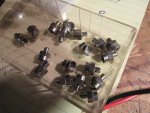Ubbe
Member
Just test with that 50 ohm calibration you have. The scanner are more or less 50 ohm so you should test with that impedance.
In reality a scanner sway a lot off from that 50 ohm down to 20 ohm up to 200 ohm and I think that it hasn't gone too much though into the antennas impedance, it's several different dipoles in parallell and each one should have a 75 ohm impedance more or less. But outside of it's narrow natural tuned frequency it also sways a lot off from that 75 ohm. And where that balun connects are very suspisous and feels out of place, it should have been connected to the two open wires nearest the mast pole but probably needed to be moved due to unforseen issues.
The balun used where probably only for easy of availability and had nothing to do with impedance match but only as a balun to connect dipoles to a coax. You probably would see much better reception with a 1:1 50 ohm - 50 ohm balun as a 300/75 will reduce the signal voltage 4 times.
It's no rocket sience. It's just a couple of dipoles tuned for different bands and connected together in the simplest way and designed to have the lowest cost possible when manufactured in batches of hundreds.
/Ubbe
In reality a scanner sway a lot off from that 50 ohm down to 20 ohm up to 200 ohm and I think that it hasn't gone too much though into the antennas impedance, it's several different dipoles in parallell and each one should have a 75 ohm impedance more or less. But outside of it's narrow natural tuned frequency it also sways a lot off from that 75 ohm. And where that balun connects are very suspisous and feels out of place, it should have been connected to the two open wires nearest the mast pole but probably needed to be moved due to unforseen issues.
The balun used where probably only for easy of availability and had nothing to do with impedance match but only as a balun to connect dipoles to a coax. You probably would see much better reception with a 1:1 50 ohm - 50 ohm balun as a 300/75 will reduce the signal voltage 4 times.
It's no rocket sience. It's just a couple of dipoles tuned for different bands and connected together in the simplest way and designed to have the lowest cost possible when manufactured in batches of hundreds.
/Ubbe


